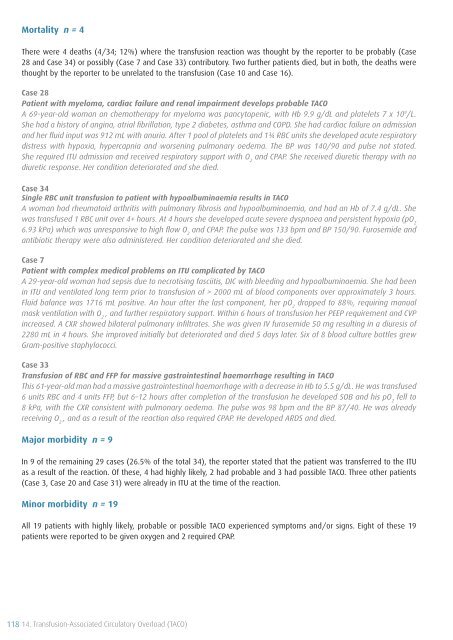SHOT Annual Report 2009 - Serious Hazards of Transfusion
SHOT Annual Report 2009 - Serious Hazards of Transfusion
SHOT Annual Report 2009 - Serious Hazards of Transfusion
You also want an ePaper? Increase the reach of your titles
YUMPU automatically turns print PDFs into web optimized ePapers that Google loves.
Mortality n = 4<br />
There were 4 deaths (4/34; 12%) where the transfusion reaction was thought by the reporter to be probably (Case<br />
28 and Case 34) or possibly (Case 7 and Case 33) contributory. Two further patients died, but in both, the deaths were<br />
thought by the reporter to be unrelated to the transfusion (Case 10 and Case 16).<br />
Case 28<br />
Patient with myeloma, cardiac failure and renal impairment develops probable TACO<br />
A 69-year-old woman on chemotherapy for myeloma was pancytopenic, with Hb 9.9 g/dL and platelets 7 x 10 9 /L.<br />
She had a history <strong>of</strong> angina, atrial fibrillation, type 2 diabetes, asthma and COPD. She had cardiac failure on admission<br />
and her fluid input was 912 mL with anuria. After 1 pool <strong>of</strong> platelets and 1¾ RBC units she developed acute respiratory<br />
distress with hypoxia, hypercapnia and worsening pulmonary oedema. The BP was 140/90 and pulse not stated.<br />
She required ITU admission and received respiratory support with O 2<br />
and CPAP. She received diuretic therapy with no<br />
diuretic response. Her condition deteriorated and she died.<br />
Case 34<br />
Single RBC unit transfusion to patient with hypoalbuminaemia results in TACO<br />
A woman had rheumatoid arthritis with pulmonary fibrosis and hypoalbuminaemia, and had an Hb <strong>of</strong> 7.4 g/dL. She<br />
was transfused 1 RBC unit over 4+ hours. At 4 hours she developed acute severe dyspnoea and persistent hypoxia (pO 2<br />
6.93 kPa) which was unresponsive to high flow O 2<br />
and CPAP. The pulse was 133 bpm and BP 150/90. Furosemide and<br />
antibiotic therapy were also administered. Her condition deteriorated and she died.<br />
Case 7<br />
Patient with complex medical problems on ITU complicated by TACO<br />
A 29-year-old woman had sepsis due to necrotising fasciitis, DIC with bleeding and hypoalbuminaemia. She had been<br />
in ITU and ventilated long term prior to transfusion <strong>of</strong> > 2000 mL <strong>of</strong> blood components over approximately 3 hours.<br />
Fluid balance was 1716 mL positive. An hour after the last component, her pO 2<br />
dropped to 88%, requiring manual<br />
mask ventilation with O 2<br />
, and further respiratory support. Within 6 hours <strong>of</strong> transfusion her PEEP requirement and CVP<br />
increased. A CXR showed bilateral pulmonary infiltrates. She was given IV furosemide 50 mg resulting in a diuresis <strong>of</strong><br />
2280 mL in 4 hours. She improved initially but deteriorated and died 5 days later. Six <strong>of</strong> 8 blood culture bottles grew<br />
Gram-positive staphylococci.<br />
Case 33<br />
<strong>Transfusion</strong> <strong>of</strong> RBC and FFP for massive gastrointestinal haemorrhage resulting in TACO<br />
This 61-year-old man had a massive gastrointestinal haemorrhage with a decrease in Hb to 5.5 g/dL. He was transfused<br />
6 units RBC and 4 units FFP, but 6–12 hours after completion <strong>of</strong> the transfusion he developed SOB and his pO 2<br />
fell to<br />
8 kPa, with the CXR consistent with pulmonary oedema. The pulse was 98 bpm and the BP 87/40. He was already<br />
receiving O 2<br />
, and as a result <strong>of</strong> the reaction also required CPAP. He developed ARDS and died.<br />
Major morbidity n = 9<br />
In 9 <strong>of</strong> the remaining 29 cases (26.5% <strong>of</strong> the total 34), the reporter stated that the patient was transferred to the ITU<br />
as a result <strong>of</strong> the reaction. Of these, 4 had highly likely, 2 had probable and 3 had possible TACO. Three other patients<br />
(Case 3, Case 20 and Case 31) were already in ITU at the time <strong>of</strong> the reaction.<br />
Minor morbidity n = 19<br />
All 19 patients with highly likely, probable or possible TACO experienced symptoms and/or signs. Eight <strong>of</strong> these 19<br />
patients were reported to be given oxygen and 2 required CPAP.<br />
118 14. <strong>Transfusion</strong>-Associated Circulatory Overload (TACO)












